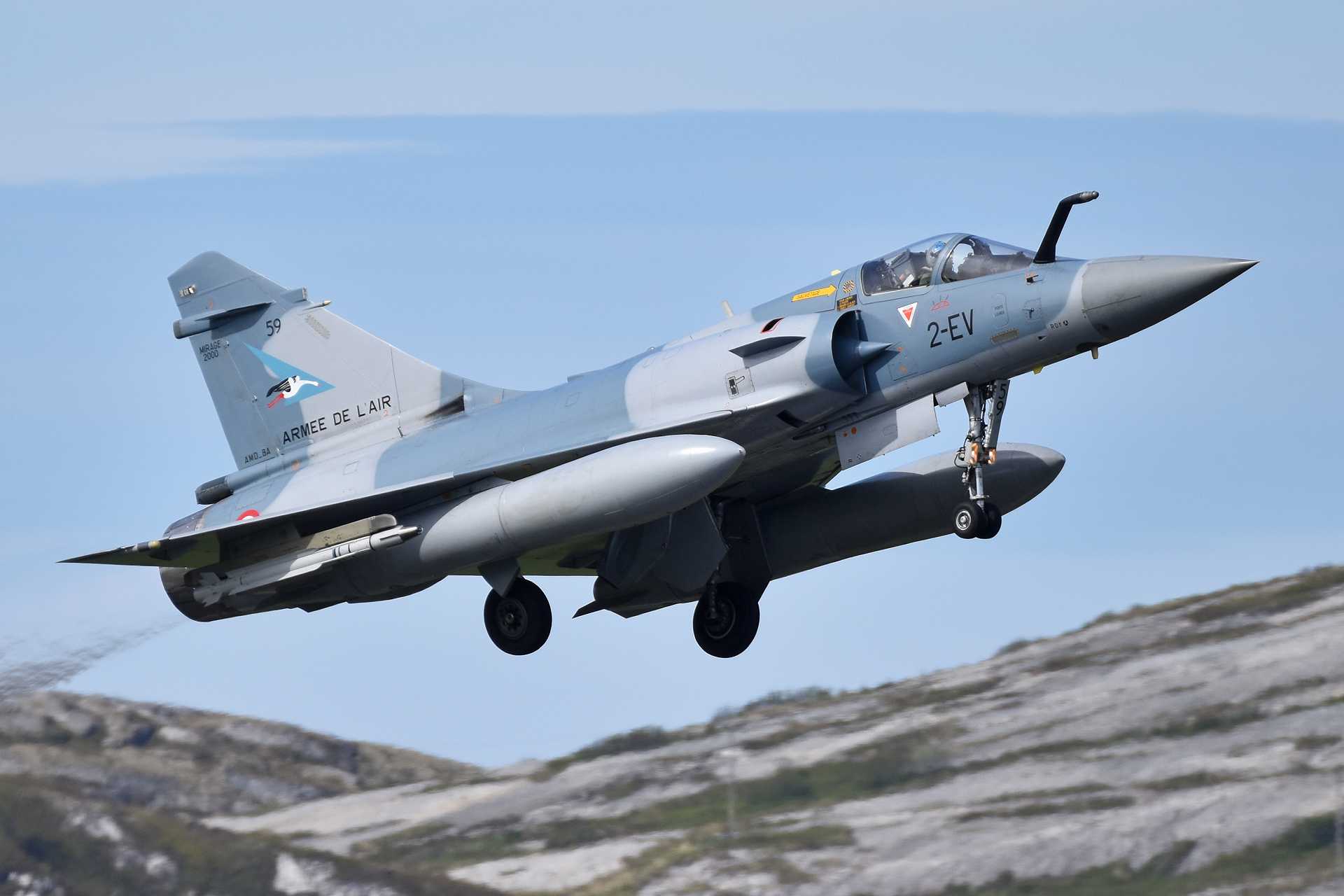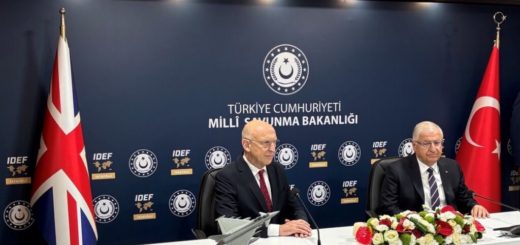Analysis: French Mirage 2000-5F Fighter Jets Demonstrate Drone-Killing Power in Middle East Confirming Their Role in Ukraine

{loadposition bannertop}
{loadposition sidebarpub}
On February 10, 2025, French Air and Space Force (Armée de l’Air et de l’Espace, AAE) Chief of Staff General Jérôme Bellanger shared a video on his LinkedIn account, showcasing a French Rafale fighter aircraft destroying a suicide drone in flight using the MICA IR (Infrared) missile. The general also highlighted that similar drones had been intercepted and neutralized by both Rafale and Mirage 2000-5F aircraft deployed in the Middle East, confirming the importance of the Mirage 2000-5F in countering Russian drone threats in the Ukraine conflict.Follow Army Recognition on Google News at this link
A French Mirage 2000-5F fighter jet of the French Air and Space Force (AAE) in flight. The Mirage 2000-5F has demonstrated its ability to intercept and destroy drones, making it a valuable asset for Ukraine in countering Russian drone threats. (Picture source: Wikimedia)
This demonstration of French Rafale fighter jet combat capabilities underscores the growing importance of advanced fighter jets in countering aerial drone threats, especially in high-intensity conflicts like Ukraine, where drone warfare has escalated dramatically. The ability of both French aircraft to engage and neutralize these drone threats effectively has proven crucial not only in the Middle East but also in strengthening the defense of Ukraine against the increasing use of drones by Russian forces.
France made the decision to provide Mirage 2000-5F aircraft to Ukraine in late 2024, responding to the growing threat posed by Russian drones, which have become a major component of Russia’s military strategy in the war against Ukraine. These UAVs, particularly suicide drones, have been used extensively to target Ukrainian military positions, civilian infrastructure, and supply lines. As these drones continue to play a prominent role in Russia’s strategy, the Mirage 2000-5F is expected to provide Ukraine with a much-needed capability to intercept and neutralize these threats. This decision was also in line with France’s broader commitment to supporting Ukraine and its NATO allies in countering Russian aggression. To ensure the effective deployment of these aircraft, the French Air Force organized several training sessions for Ukrainian pilots and ground crews. These training programs, carried out in France and Ukraine, were aimed at ensuring smooth integration of the Mirage 2000-5F into the Ukrainian Air Force’s operations. The first round of training took place in January 2025, with additional sessions planned for the following months.
France’s commitment to sending Mirage 2000-5F aircraft to Ukraine highlights the broader European and NATO strategy to support Ukraine’s defense efforts. With air superiority being a critical factor in modern warfare, the addition of this advanced aircraft strengthens Ukraine’s ability to defend its airspace, counter drone incursions, and protect its sovereignty from ongoing Russian aggression.
The Mirage 2000 family of aircraft, developed by Dassault Aviation in the 1980s, has been a mainstay of the French Air Force and other international operators. Among the various versions of the Mirage 2000, the Mirage 2000-5 is one of the most advanced, designed specifically for multi-role missions with a focus on air superiority and precision strike capabilities. The Mirage 2000-5F is an upgraded version tailored to the French Air Force’s specific needs, offering enhanced avionics, improved radar systems, and increased operational flexibility. With its highly capable RDI (Radar Doppler à Impulsions) radar, the Mirage 2000-5F can effectively detect and track small, low-flying objects such as drones. This makes it an ideal asset for air-defense missions in environments where drone threats are prominent. The delta-wing design of the aircraft also grants it superior agility, making it highly responsive to fast-moving targets, a key advantage when engaging drones that are typically small, fast, and hard to intercept.
The Mirage 2000-5F is equipped with several key features that make it well-suited for countering drone threats. The aircraft’s RDI radar is capable of detecting and tracking a variety of aerial targets, including small UAVs, with multi-target tracking capabilities that allow the Mirage 2000-5F to engage several threats simultaneously. This is crucial in high-density environments where multiple drones may be operating at once. Additionally, the aircraft is armed with the highly effective MICA IR (Infrared) missile, which can engage fast-moving, low-flying targets with high precision. The MICA IR missile, with a range of over 60 kilometers, is designed to target agile UAVs, delivering a devastating strike with minimal collateral damage, making it an ideal weapon for neutralizing suicide drones or reconnaissance UAVs in hostile environments.
Though not as commonly used for drone threats, the Super 530D radar-guided missile could be employed in situations where larger, more resilient aerial threats, such as long-range UAVs, need to be neutralized. This missile provides the Mirage 2000-5F with an additional layer of versatility in complex combat environments. The aircraft is also equipped with advanced electronic warfare (EW) systems that enhance its survivability in contested environments. These systems can jam enemy radar and communications, which is critical when operating against adversaries deploying drones and other remotely controlled platforms. The Mirage 2000-5F’s delta-wing design also ensures high maneuverability, allowing it to quickly change course and altitude, which is crucial when intercepting fast-moving drones operating at varying altitudes and speeds.
On February 10, 2025, General Jérôme Bellanger, Chief of Staff of the French Air and Space Force, shared a video on LinkedIn showcasing the Rafale fighter aircraft intercepting and destroying a suicide drone using a MICA IR missile. The general also highlighted that similar drone threats had been neutralized by both Rafale and Mirage 2000-5F aircraft in Middle Eastern operations. The video provided rare, real-time footage of the aircraft successfully neutralizing a UAV, underscoring the Mirage 2000-5F’s role in countering aerial threats. In the Middle East, French forces have used the Mirage 2000-5F and Rafale to protect both military and civilian assets from drone attacks, particularly from groups like the Houthi rebels, who have used drones to target maritime traffic and military positions. These operations highlight the Mirage 2000-5F’s versatility in various operational environments, from securing airspace to intercepting hostile drones.
The Mirage 2000-5F now plays a crucial role in Ukraine’s ongoing defense against Russian drone attacks. Since Russia has increasingly relied on UAVs to strike Ukrainian military infrastructure, the addition of these French aircraft significantly enhances Ukraine’s ability to intercept and neutralize these threats at longer ranges. The Mirage 2000-5F, along with the Rafale, provides Ukraine with advanced capabilities to protect its airspace and counter aerial assaults by Russia. In addition to its missile capabilities, the Mirage 2000-5F’s radar and electronic warfare systems offer Ukraine critical advantages in monitoring and neutralizing Russian UAVs that have been used to attack everything from command centers to power plants. With these aircraft, Ukraine strengthens its position in the ongoing conflict, receiving vital air defense tools in the form of one of the most advanced fighter jets in the French arsenal.
The growing reliance on drones in the Russian-Ukrainian war emphasizes the need for effective countermeasures in modern warfare. The Mirage 2000-5F has proven itself as a formidable asset in this regard, both in the Middle East and now in Ukraine, offering advanced radar systems, highly capable missile armament, and superb maneuverability to counter the evolving aerial threats posed by drones. With France’s decision to supply these aircraft to Ukraine, the Mirage 2000-5F stands as a key component in the defense against Russian drone attacks, solidifying its place as an essential tool in modern air combat and air defense operations.

{loadposition bannertop}
{loadposition sidebarpub}
On February 10, 2025, French Air and Space Force (Armée de l’Air et de l’Espace, AAE) Chief of Staff General Jérôme Bellanger shared a video on his LinkedIn account, showcasing a French Rafale fighter aircraft destroying a suicide drone in flight using the MICA IR (Infrared) missile. The general also highlighted that similar drones had been intercepted and neutralized by both Rafale and Mirage 2000-5F aircraft deployed in the Middle East, confirming the importance of the Mirage 2000-5F in countering Russian drone threats in the Ukraine conflict.
A French Mirage 2000-5F fighter jet of the French Air and Space Force (AAE) in flight. The Mirage 2000-5F has demonstrated its ability to intercept and destroy drones, making it a valuable asset for Ukraine in countering Russian drone threats. (Picture source: Wikimedia)
This demonstration of French Rafale fighter jet combat capabilities underscores the growing importance of advanced fighter jets in countering aerial drone threats, especially in high-intensity conflicts like Ukraine, where drone warfare has escalated dramatically. The ability of both French aircraft to engage and neutralize these drone threats effectively has proven crucial not only in the Middle East but also in strengthening the defense of Ukraine against the increasing use of drones by Russian forces.
France made the decision to provide Mirage 2000-5F aircraft to Ukraine in late 2024, responding to the growing threat posed by Russian drones, which have become a major component of Russia’s military strategy in the war against Ukraine. These UAVs, particularly suicide drones, have been used extensively to target Ukrainian military positions, civilian infrastructure, and supply lines. As these drones continue to play a prominent role in Russia’s strategy, the Mirage 2000-5F is expected to provide Ukraine with a much-needed capability to intercept and neutralize these threats.
This decision was also in line with France’s broader commitment to supporting Ukraine and its NATO allies in countering Russian aggression. To ensure the effective deployment of these aircraft, the French Air Force organized several training sessions for Ukrainian pilots and ground crews. These training programs, carried out in France and Ukraine, were aimed at ensuring smooth integration of the Mirage 2000-5F into the Ukrainian Air Force’s operations. The first round of training took place in January 2025, with additional sessions planned for the following months.
France’s commitment to sending Mirage 2000-5F aircraft to Ukraine highlights the broader European and NATO strategy to support Ukraine’s defense efforts. With air superiority being a critical factor in modern warfare, the addition of this advanced aircraft strengthens Ukraine’s ability to defend its airspace, counter drone incursions, and protect its sovereignty from ongoing Russian aggression.
The Mirage 2000 family of aircraft, developed by Dassault Aviation in the 1980s, has been a mainstay of the French Air Force and other international operators. Among the various versions of the Mirage 2000, the Mirage 2000-5 is one of the most advanced, designed specifically for multi-role missions with a focus on air superiority and precision strike capabilities. The Mirage 2000-5F is an upgraded version tailored to the French Air Force’s specific needs, offering enhanced avionics, improved radar systems, and increased operational flexibility. With its highly capable RDI (Radar Doppler à Impulsions) radar, the Mirage 2000-5F can effectively detect and track small, low-flying objects such as drones. This makes it an ideal asset for air-defense missions in environments where drone threats are prominent. The delta-wing design of the aircraft also grants it superior agility, making it highly responsive to fast-moving targets, a key advantage when engaging drones that are typically small, fast, and hard to intercept.
The Mirage 2000-5F is equipped with several key features that make it well-suited for countering drone threats. The aircraft’s RDI radar is capable of detecting and tracking a variety of aerial targets, including small UAVs, with multi-target tracking capabilities that allow the Mirage 2000-5F to engage several threats simultaneously. This is crucial in high-density environments where multiple drones may be operating at once. Additionally, the aircraft is armed with the highly effective MICA IR (Infrared) missile, which can engage fast-moving, low-flying targets with high precision. The MICA IR missile, with a range of over 60 kilometers, is designed to target agile UAVs, delivering a devastating strike with minimal collateral damage, making it an ideal weapon for neutralizing suicide drones or reconnaissance UAVs in hostile environments.
Though not as commonly used for drone threats, the Super 530D radar-guided missile could be employed in situations where larger, more resilient aerial threats, such as long-range UAVs, need to be neutralized. This missile provides the Mirage 2000-5F with an additional layer of versatility in complex combat environments. The aircraft is also equipped with advanced electronic warfare (EW) systems that enhance its survivability in contested environments. These systems can jam enemy radar and communications, which is critical when operating against adversaries deploying drones and other remotely controlled platforms. The Mirage 2000-5F’s delta-wing design also ensures high maneuverability, allowing it to quickly change course and altitude, which is crucial when intercepting fast-moving drones operating at varying altitudes and speeds.
On February 10, 2025, General Jérôme Bellanger, Chief of Staff of the French Air and Space Force, shared a video on LinkedIn showcasing the Rafale fighter aircraft intercepting and destroying a suicide drone using a MICA IR missile. The general also highlighted that similar drone threats had been neutralized by both Rafale and Mirage 2000-5F aircraft in Middle Eastern operations. The video provided rare, real-time footage of the aircraft successfully neutralizing a UAV, underscoring the Mirage 2000-5F’s role in countering aerial threats. In the Middle East, French forces have used the Mirage 2000-5F and Rafale to protect both military and civilian assets from drone attacks, particularly from groups like the Houthi rebels, who have used drones to target maritime traffic and military positions. These operations highlight the Mirage 2000-5F’s versatility in various operational environments, from securing airspace to intercepting hostile drones.
The Mirage 2000-5F now plays a crucial role in Ukraine’s ongoing defense against Russian drone attacks. Since Russia has increasingly relied on UAVs to strike Ukrainian military infrastructure, the addition of these French aircraft significantly enhances Ukraine’s ability to intercept and neutralize these threats at longer ranges. The Mirage 2000-5F, along with the Rafale, provides Ukraine with advanced capabilities to protect its airspace and counter aerial assaults by Russia. In addition to its missile capabilities, the Mirage 2000-5F’s radar and electronic warfare systems offer Ukraine critical advantages in monitoring and neutralizing Russian UAVs that have been used to attack everything from command centers to power plants. With these aircraft, Ukraine strengthens its position in the ongoing conflict, receiving vital air defense tools in the form of one of the most advanced fighter jets in the French arsenal.
The growing reliance on drones in the Russian-Ukrainian war emphasizes the need for effective countermeasures in modern warfare. The Mirage 2000-5F has proven itself as a formidable asset in this regard, both in the Middle East and now in Ukraine, offering advanced radar systems, highly capable missile armament, and superb maneuverability to counter the evolving aerial threats posed by drones. With France’s decision to supply these aircraft to Ukraine, the Mirage 2000-5F stands as a key component in the defense against Russian drone attacks, solidifying its place as an essential tool in modern air combat and air defense operations.






